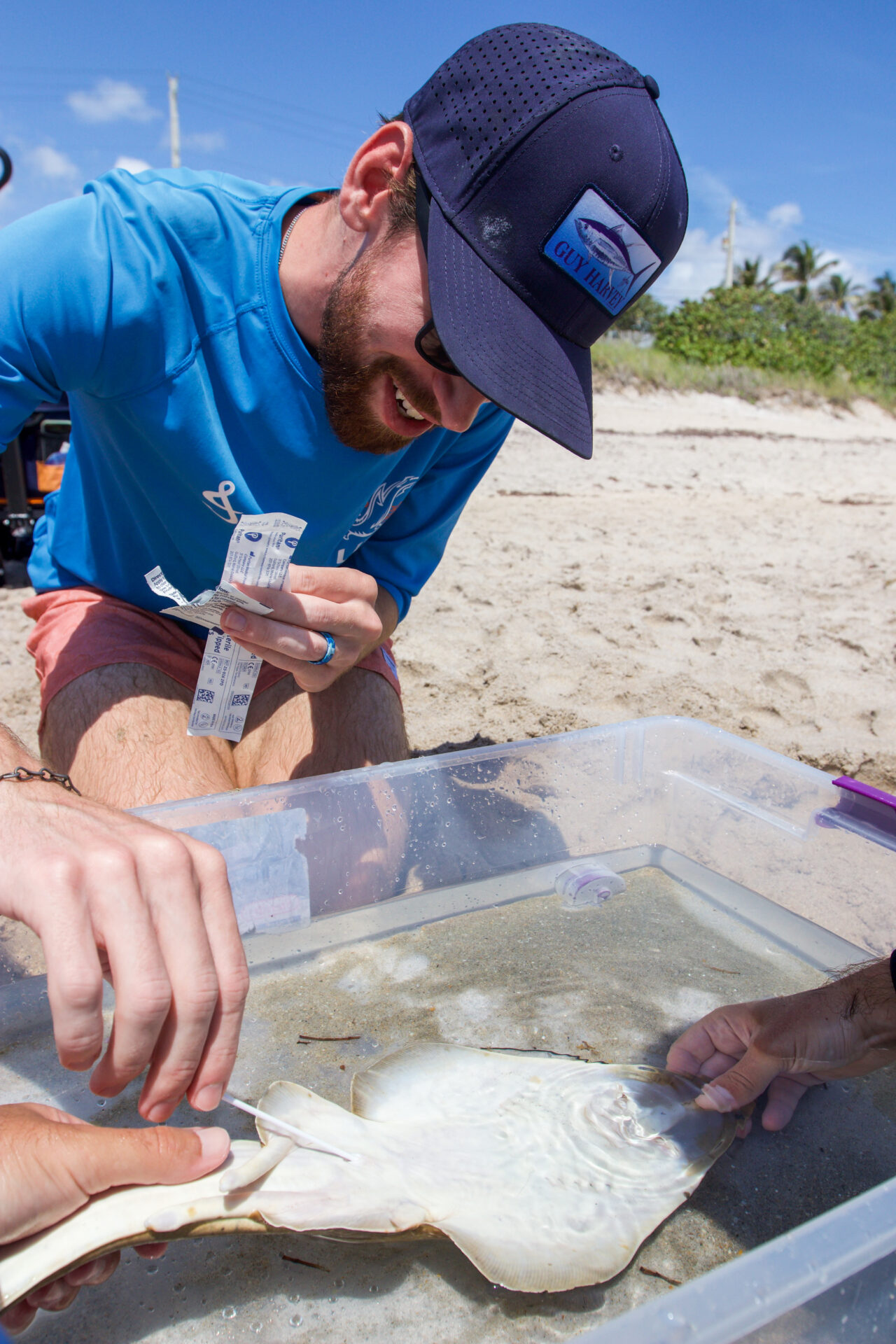Guitarfish on stage
Found along the North American coasts of the Atlantic and Gulf of Mexico, the Atlantic guitarfish (Pseudobatos lentiginosus) is a Vulnerable species of ray that is a seldom known and even more seldom studied. So, when the opportunity presented itself for members of my lab at the University of Miami to work with the guitarfish, I had to hop on the bandwagon.

Atlantic guitarfish are placed in a shallow seawater-filled bin for measurements and sample collection after snorkelers gently capture and swim them to shore. Photo © Nicole Bozkurt | University of Miami Shark Research and Conservation Program
As a PhD student in the Shark Research and Conservation Lab, I research the trophic dynamics of the elasmobranch community of Biscayne Bay’s estuarine and nearby coastal habitats, especially focusing on their unique function as a nursery area for numerous species, including the great hammerhead shark (Sphyrna mokarran). The guitarfish—a corner-bar musician compared to the rock-and-roll celebrity that is the great hammerhead—offered me the opportunity to apply the methods used throughout my dissertation on a species that has received far too little research and management attention. Specifically, through stable isotope analysis of muscle tissue and swabs of dietary DNA from the digestive tract, I aim to generate estimates of the guitarfish’s niche and to reconstruct their diet. The information these methods provides will paint a picture of the resilience or vulnerability of the guitarfish to disturbances in prey items and habitat resources on which it depends: a species that can use a wide variety of prey and habitat resources is more robust to disturbance while one that uses a narrow few is alarmingly not.

A swab of the guitarfish’s cloaca collects trace amounts of dietary DNA that will be amplified, sequenced, and taxonomically assigned via a method known as DNA metabarcoding. Photo © Nicole Bozkurt | University of Miami Shark Research and Conservation Program
Oddly enough, guitarfish are not abundant in the shallow habitats surrounding Biscayne Bay, and so to carry out my project, the wheels of the tour bus must hit the road north to Palm Beach and Broward Counties. At the outset, my fear was that finding this cryptic camouflage expert via beach snorkelling would be challenging. Indeed, our first trip was unsuccessful, and we returned home empty handed having seen everything from sea turtles, to stingrays, to snook and tarpon, but no guitarfish. However, with each trip, our eyes adjusted and saw that there, lightly buried on the sandy hard-bottom just yards from the shore, were numerous guitarfish. (Although some days we still don’t find any).
After gently placing a net over them, we swim them back to shore where we perform our scientific work-up in a shallow seawater-filled bin on the sand, with beachgoers walking all around us. My initial hesitation to sample in such a public setting was quickly replaced: it was the lack of interest in what we were doing that shocked me. Many people barely even bothered to glance over, and those who stopped to talk with us often did not even stick around long enough to see the animal that they had never even heard of, much less knew was there in the sand beneath the waves they swam in (n.b., this is a completely harmless species to humans, lacking even the barb that its stingray relatives have).
But then a young boy timidly approached and asked if he could watch. He quietly kneeled on the sand looking in wonder as we took our samples and released the guitarfish. His presence reminded me: we must not let our busy lives be the enemy of curiosity, for it is curiosity that fuels questions, questions that help us to care, and care that motivates us to conserve.
